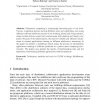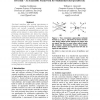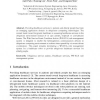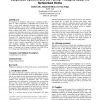CSCWD
2007
Springer
14 years 5 months ago
2007
Springer
Ubiquitous computing is increasingly becoming part of our lives. Various computing devices, having different sizes and capabilities, and using different software platforms are part...
SOCA
2007
IEEE
14 years 5 months ago
2007
IEEE
The emerging ubiquitous computing vision is characterized by decentralized and ad hoc interoperation among devices and networks for access to services. Interacting devices or grou...
IPC
2007
IEEE
14 years 5 months ago
2007
IEEE
Pervasive computing refers to making many computing devices available throughout the physical environment, while making them effectively invisible to the user. To further increase...
HICSS
2007
IEEE
14 years 5 months ago
2007
IEEE
Pen-based interfaces offer exciting opportunities in ubiquitous computing by enabling new hardware form factors and socially acceptable computing tasks. However, prevailing ink re...
COMPSAC
2007
IEEE
14 years 5 months ago
2007
IEEE
Building realistic end user scenarios for ubiquitous computing applications entails large up-front investments. Many context adaptive applications so far fail to live up to their ...
SUTC
2008
IEEE
14 years 5 months ago
2008
IEEE
One of the challenges in ubiquitous computing is that of mobility, which typically requires interaction between intelligent environments in different domains of administration. We...
ICDE
2008
IEEE
14 years 6 months ago
2008
IEEE
— The emergence of wireless sensor networks (WSN) and RFID technology are starting to make the ubiquitous computing vision a reality, as they provide the means to obtain informat...
APCHI
2008
IEEE
14 years 6 months ago
2008
IEEE
Providing healthcare services to patients and elderly people has been an emerging application domain in ubiquitous computing technologies. The current trend toward long-term health...
SOUPS
2009
ACM
14 years 6 months ago
2009
ACM
Developments in ubiquitous and pervasive computing herald a future in which computation is embedded into our daily lives. Such a vision raises important questions about how people...
BSN
2009
IEEE
14 years 6 months ago
2009
IEEE
— Most visions of ubiquitous computing anticipate a world permeated by a dense sampling of sensors, many of which will be capable of capturing, analyzing, and transmitting person...




